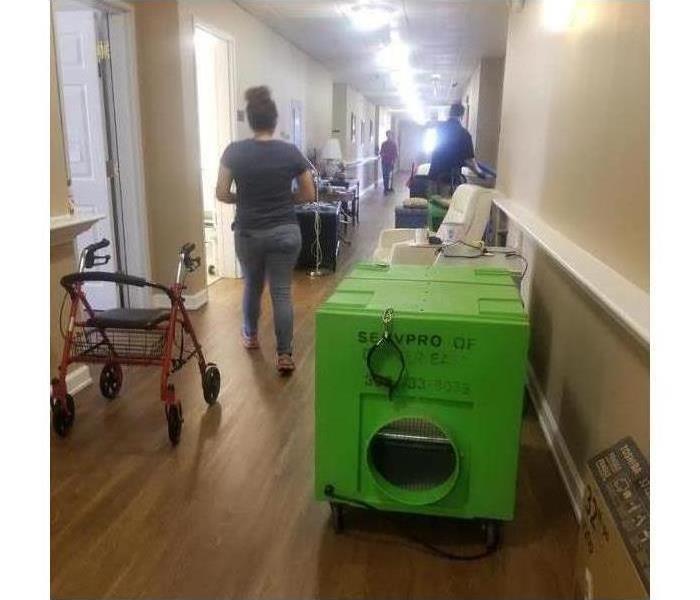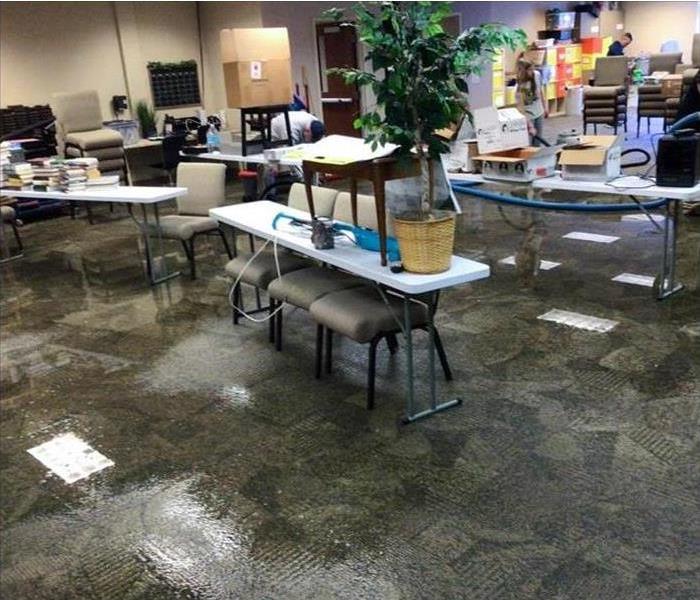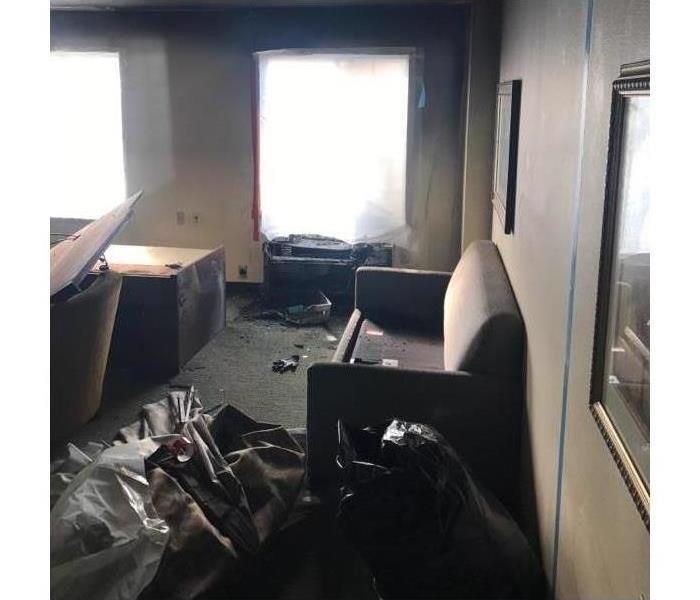Archived Commercial Blog Posts
Creating an Office Fire Escape Plan
10/7/2022 (Permalink)
Creating a Fire Escape Plan For Your Workplace
When it comes to fire safety, there are many things you should do. You need to check smoke alarms and practice your fire drill twice a year—and that's just a start. One of the most important steps you can take is creating an emergency escape plan and practicing it with all employees at least twice a year. Here are some tips for creating a fire escape plan for your workplace:
Create a Plan Before the Emergency
Creating a fire escape plan should be done before you have an emergency. If you wait until there's a fire, it will be much more difficult to come up with the best way to get everyone out safely. A good plan is simple and practical, so everyone can follow it easily in an emergency situation. You should also make sure that all employees know about your plan and practice using it regularly, so they'll know what to do when they need to use it.
Your fire escape plan should include:?
- A diagram of all exits from the building or room you're in (how many doors are there? Where do they lead?)
- A list of items that could block those exits (furniture or equipment) and how these things will be moved aside before fleeing through them (if possible)
- Directions for escaping through each exit by floor level if necessary (for example: "Go down one flight of stairs and exit at the end of this hallway")
Designate a Meeting Place Outside
You should be prepared to meet outside. Go outside and move at least 100 feet away from the building. If there is smoke or fire in the stairwell, go back up to your office and wait until help arrives.
Test Smoke Alarms Monthly
Test and check your smoke alarms monthly. Smoke alarms should be tested by pressing the test button on the unit at least once a month. If it goes off, make sure that it's working properly and replace it if needed. If you are in a building with multiple floors, check all smoke alarms on each level of the building to make sure they're working properly and not sounding false alarms when there isn't a fire (for example, if you've been cooking something particularly smoky).
Practice your fire drill twice a year and include all your employees.
You should practice your fire drill twice a year, including all employees. If you have more than one location, it is important to have them coordinated so that they are as close to the same time as possible.
In addition to practicing the actual fire escape plan, make sure that everyone knows where the nearest exit doors are located in case there is an emergency and they need to evacuate immediately in their offices or conference rooms.
An effective escape plan can save lives in an emergency, like a fire in your business. You must have a fire escape plan for every employee and visitor in the building. Having this information available can help you make decisions about how best to handle emergencies and what to do if you are trapped by flames or smoke.
We hope that by reading this article, you have learned how to create an effective fire escape plan for your Denver home. By following these steps and setting up a regular practice schedule with your employees, you can make sure that everyone is prepared for an emergency situation.
When your business catches on fire, SERVPRO of Denver East & Southwest is here to help. Give us a call!
4 Stages of the Water Mitigation Process
8/26/2022 (Permalink)
 Commercial water mitigation in Hampden, CO
Commercial water mitigation in Hampden, CO
The Following Will Be Done During Mitigation
If your Hampden, CO, building is damaged by water caused by a leak or broken pipe, you will need to go through the restoration process to return it to a safe condition. An important part of the process is mitigation which includes pipe burst cleanup and other steps taken to limit the damage before repairs can begin.
1. Inspection
Before pipe burst cleanup can be done or any repairs can be made, the water damage remediation company will need to inspect the building. During the inspection, they will locate the source of the problem and determine what areas have suffered damage. Once this is done, they can figure out how to proceed.
2. Water Removal
The first step after the inspection will often be water cleanup. Any excess water will need to be removed from the building to prevent further damage. If allowed to sit too long, water can cause warping wood, rusting metal, and other problems.
3. Drying
Simply removing the excess water is usually not enough to prevent damage. Any moisture that remains can contribute to the growth of mold in your building and can weaken building materials. Dehumidifiers can be useful during this step to remove moisture present in the air as well. This will help prevent high humidity levels.
4. Cleanup
Once the water has been removed and the building has been dried, pipe burst cleanup can officially begin. During this stage, both the building and affected belongings will need to be cleaned. Surfaces will be scrubbed and disinfected. Items that can be salvaged will go through various types of cleaning, including dry cleaning and antibacterial treatments. Severely damaged items may need to be replaced instead.
A supply line leaking or a broken pipe can cause quite a bit of water damage. Having mitigation done as soon as possible will limit this damage and will reduce the amount of time and money that needs to be spent on repairs.
How To Minimize Costs With Business Interruption Insurance
6/21/2022 (Permalink)
When an emergency situation such as flooding from a broken pipe or a natural disaster temporarily closes your business in Glendale, CO, business interruption insurance helps tide you over until you reopen. However, most insurance policies have specific qualifications. Understanding your policy and working with a professional restoration company will lower costs and efficiently get you back in business.
What Is Business Interruption Insurance?
Business interruption insurance, also known as business income coverage, helps cover operating expenses in the case of temporary closure. Policies generally assist with lost net income during the restoration period, as well as help pay for:
- Taxes
- Loans
- Payroll
- Mortgage or rent
How Can You Lower Costs in the Case of Large Water Damage?
Knowing your policy’s limits and stipulations is key for saving your company time and money. Typically, the restoration period does not start until 48 to 72 hours after an emergency strikes your business. Standard policies limit the restoration period to 30 days, although you can extend this through an added endorsement.
Once you know how long you have to restore your property under your insurance policy, work with an efficient clean-up crew that can help you lower your costs by recovering the damage quickly. Communication with your coverage provider and your restoration company enables you to reopen your doors as soon as possible.
What Does Your Insurance Cover?
It’s also important to know what kind of disasters your insurance covers. Some policies will cover damage from flooding caused by a mechanical problem but won’t cover damage from a natural flood, as that is under different insurance.
Protect your business during the aftermath of a significant disaster like flooding from a burst pipe with a business interruption policy. Understanding how your policy works and working with an efficient team will lower your insurance costs and quickly get your business back on its feet.
What Is Category 1 Water Damage?
4/26/2022 (Permalink)
 Commercial water damage in Glendale, CO.
Commercial water damage in Glendale, CO.
What Is Water Damage in Category 1?
Water damage is categorized in different ways based on the cleanliness of the water and what contaminants it may contain. Category 1 is considered clean water.
Sources
There are several potential sources of category 1 water:
- Supply line: broken pipe
- Overflow: sinks or bathtubs
- Toilets: broken tank
- Environmental: rain, snow or ice
Damage
Since category 1 is clean water, it will not contaminate things it touches with any harmful microorganisms. Therefore, most items damaged in the flood can able be salvaged by simply drying and cleaning them. However, any type of water can cause mold growth. Mold grows in wet or moist areas, so if the flooding is not properly dried and treated, you could develop a mold problem. Fluid and mold can also deteriorate building materials, such as wood, and cause structural damage. A water damage restoration service in Glendale, CO, can dry the area, clean it with antibacterial sprays to prevent mold growth and check for structural damage.
Cleaning and Drying
Water is an excellent conductor of electricity, meaning contact with water that is touching any part of an electrical circuit can result in electrocution. You should turn off the power in the flooded area before attempting to clean the fluid.
Once the electricity is turned off, you should remove items the water has touched and move them to a place where they can dry. You should then open windows and doors to help dry the area. You can then begin soaking up the water with towels or using a pump to remove the water depending on the extent of the flooding. Once you have removed most of the liquid, you can plug in fans to help dry the area faster. Lastly, you should have a professional treat the area for mold growth.
Category 1 is considered clean water and typically results in less damage than categories 2 and 3. If you know the right cleaning procedures, you can minimize damage and salvage most items that come into contact with the water.
The Complicated World of Mold Insurance Claims
4/11/2022 (Permalink)
Mold Insurance Claims
You can count on commercial insurance to cover your business in Cheesman Park, CO, in the case of many perils. When it comes to mold insurance claims, though, there are several unknowns and gray areas. This isn't too unusual in the insurance industry, but it can be even more complicated when dealing with mold. For this reason, it is always in your best interest to speak in-depth with your insurance agent. Most policies have a fungus exclusion, which rules out coverage and payments, but there is also a thing called limited fungus coverage. This typically does provide some money to business owners for fungus damage, repair and repair under specified and named conditions.
Company Responsibility
There are several situations that are pretty clear when it comes to mold insurance claims. If you have acted negligently or improperly in maintaining your property, the insurance company is unlikely to honor a claim. This can take many forms:
- Failure to maintain an adequate roof system
- Failure to repair leaks
- Incompetence in cleaning up after a flood
- Failure to act on repairs in a timely fashion
In other words, if your company could have done something to limit damages and did not, and this inaction resulted in mold damage, the insurance provider will deny a mold claim. If you find mold on your property, it is crucial to take swift, appropriate action.
Mold Remediation
A professional mold mitigation franchise is your best protection against a fungal outbreak. A SERVPRO team is Faster to Any Size Disaster and they will come to your facility in a matter of hours. Trained technicians will work to stop and remove any standing water in the building, often the cause of mold growth, and they will take action to contain the spread of microscopic mold spores. The rest of the process includes removal, cleaning and restoration of damages. The franchise, experienced with mold insurance claims, will help document any damages and repair costs to speed up the claims process.
4 Tips on Conducting an Emergency Fire Drill at Work
2/21/2022 (Permalink)
When Practicing An Emergency Fire Drill At Work, There Are Four Things To Keep In Mind.
Unexpected emergencies can creep up on anyone at any time, even at work. Fires can be one of the most feared dangers because of the smoke, flames, and inability to see. That is why many business owners choose to have a fire drill in place for their employees. Once the drill is in place, employees can be certain of their escape route, which will aid in almost any other possible emergencies as well, such as windstorms, tornadoes, or gas leaks. Here are five steps to help you create a safety drill in Congress Park, CO.
1. Alarms should be distinct. Alarms should also be connected to an auxiliary power source. Make sure the sound of the alarm can be heard throughout the building, including the restrooms and breakrooms. Also, test alarms monthly and replace batteries twice a year. When beginning the drill, use the alarm to familiarize employees with the sound.
2. Give emergency action plan information to all employees. The plan should include an escape route, designated meeting area outside the building, and special safety instructions. Also, consider offering a short presentation once a year on fire drill strategies and ask for employee input.
3. The evacuation route should be tailored to your employee’s needs. The path should be free of debris and allow everyone to exit the building easily. If you employ a disabled individual, the route should accommodate his or her needs as well. Once the path has been established, post signs along the exit walls.
4. Appoint a safety committee to perform a disaster drill monthly. After each drill, management and committee members may consider meeting to discuss concerns about the effectiveness of the drill. This allows you to revise your emergency action plan as needed and contact professionals with any questions that arise.
Conducting a disaster preparedness fire drill at work can keep employees from becoming overwhelmed during a crisis. By using the four steps listed above, you can make sure that if a disaster hits Congress Park, CO, your employees know what to do.
How To Prevent Break Room Fires and Banish Foul Food Odors
1/28/2022 (Permalink)
 Smoke damage in North Park Hill, CO.
Smoke damage in North Park Hill, CO.
How to Avoid Break Room Fires and Get Rid of Bad Food Odors
Having a break room for employees in a commercial building can make the days more pleasant. Being able to brew a fresh cup of tea during a long afternoon or cook hot popcorn can lift everyone’s spirits and ease the work along. Improper use of appliances and careless housekeeping, however, can at best lead to foul odors and at worst set off dangerous fires.
One dreaded workplace scenario is burned popcorn. Property owners and managers may not realize, though, that smoke cleanup methods from a professional fire restoration company may also include effective building deodorization. The following measures can fend off break room fires and prevent burned food from wafting foul odors throughout the facility.
• Think heavy-duty. In a workplace break room, use only industrial-grade appliances that are UL-listed.
• Forget extension cords. Plug all appliances directly into outlets with proper overcurrent protection such as breakers and GFCIs.
• Get detection. Install smoke and heat detection devices in all break rooms. These systems should be monitored by a central station.
• Clean up. Keep all appliances and outlets free from dirt and debris. Doing so not only helps with safety considerations, but it can also reduce unpleasant odors.
A Dreaded Workplace Break Room Mishap
Everyone in the office immediately knows it has happened. Burned popcorn never stays a secret. The smell wafts through every air vent and settles into each office, lobbies and waiting areas so that customers are greeted by the stench while employees have to work on despite the bad smell.
Many commercial property owners and managers have a fire restoration and cleanup team on file in the event of a major disaster. However, this same specialist company can also clean foul odors from the air using advanced equipment and techniques so that everyone can breathe easier.
If your office in North Park Hill, CO, is riddled with burned popcorn smell, a fire restoration company experienced in smoke cleanup can provide thorough building deodorization from unpleasant break room odors. Work and business go better and smoother in a safe, clean environment.





 24/7 Emergency Service
24/7 Emergency Service


